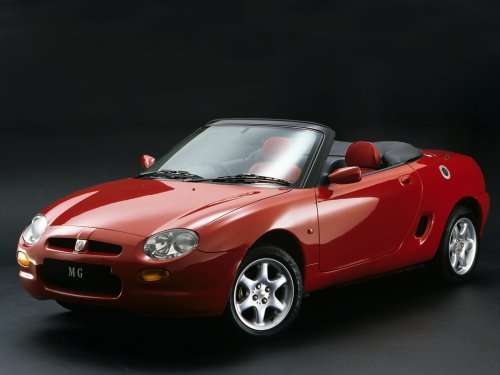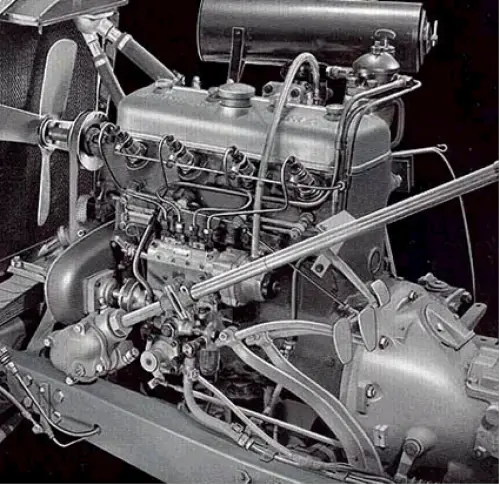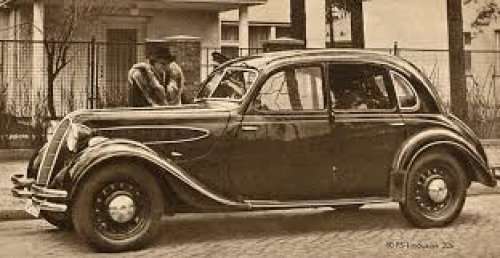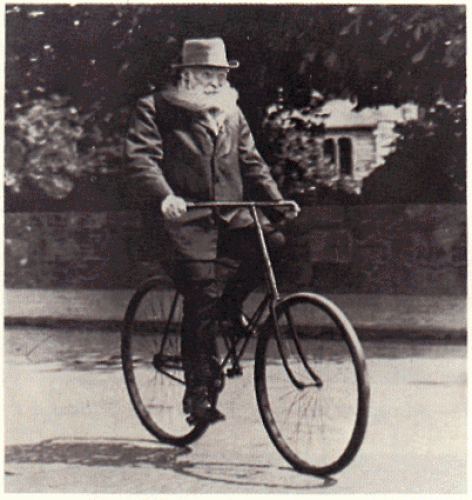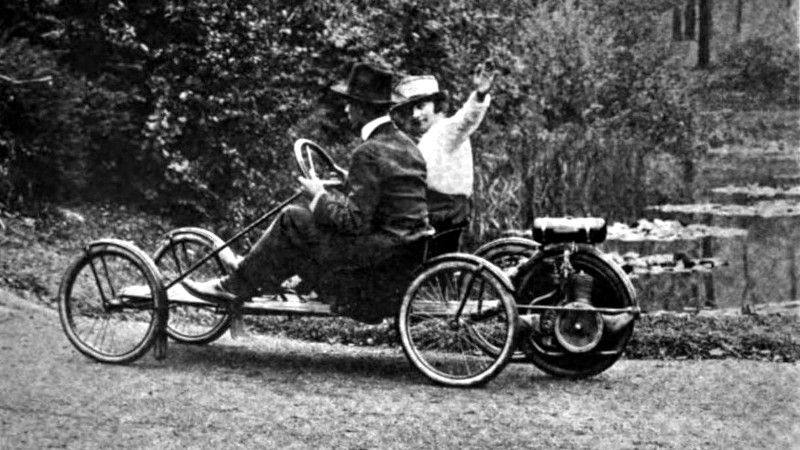Friday 17th February 1995
The famous MG sports car brand, not seen on a volume sports car since 1980, was revived when the Rover Group unveiled the new MGF sports car which went on sale in the autumn of 1995. It was powered by a 1.8 L K-Series 16-valve engine, the basic having 118 hp (87 kW) while the more powerful VVC (variable valve control) had 143 hp (107 kW). Rover Special Projects oversaw the development of the F’s design and before finalising the styling bought-in outside contractors to determine the most appropriate mechanical configuration for the new car. Steve Harper of MGA Developments produced the initial design concept in January 1991 (inspired by the Jaguar XJR-15 and the Ferrari 250LM), before Rover’s in house design team refined the concept under the leadership of Gerry McGovern. An interesting feature of the F was its Hydragas suspension, a system employing interconnected fluid and gas displacers which provided a surprisingly compliant ride but which could be tuned to provide excellent handling characteristics. The MG F quickly shot to the top of the affordable sports car charts in Britain and remained there until the introduction of the MG TF in 2002.
#motoring
Saturday 15th February 1936
The Mercedes-Benz 260D – the world’s first production diesel-powered passenger car – debuted at the Berlin Auto Show. Based on the 200 model, the 260D used a 2.6-litre 4-cylinder diesel engine mated to a Bosch mechanical injection pump. The ensemble allowed the car to produce 45hp of power at 3,200 rpm. Almost 2,000 units were built through 1940. The car initially had a 3-speed gearbox; and was upgraded with electric coil ignitors in 1938. One of the diesel powerplant’s main benefits – then as now – was reduced fuel consumption. The 260D burned 9 l/100 km (26 mpg U.S.) compared to 13 l/ 100 km (18 mpg U.S.) in the gasoline counterpart. Another bonus: at the time, diesel was half the price of gasoline, so the motorists saved a lot of cash at the pump. The SS and Gestapo made use of these vehicles for more sinister purposes – the hunting of Jews. If one saw the 260D coming, trouble was to be expected. The Mercedes 260D ultimately became associated as an infamous “Death Mobile” instead of known as the first diesel passenger car.
Friday 15th February 1935
BMW’s stylistically and technologically innovative flagship model, the 70 mph BMW 326, was launched at the 26th German International Motor Show Berlin. Available as a saloon, a two-door and four-door convertible, it was the first BMW to sport a streamlined body, a hydraulic braking system and a concealed spare wheel. The car featured a 2 litre 6 cylinder engine with two carburettors, whose power of 50 bhp was transmitted to the wheels in 1st and 2nd gear by a partially synchronised four-speed transmission with freewheel. Daimler-Benz presented the new car models 170 V (W 136) and 170 H (W 28) as well as the model 260 D (W 138), the world’s first series-produced diesel passenger car at the show.
Friday 7th December 1888
John Boyd Dunlop, a Scottish inventor, was issued a patent for his pneumatic tyre. In 1887, when his 9-year-old son had complained of the rough ride he experienced on his tricycle over the cobbled streets of Belfast, Dunlop had devised and fitted rubber air tubes held on to a wooden ring by tacking a linen-covering fixed around the wheels. Due to the major improvement in riding comfort, Dunlop continued development until he patented the idea.
#Cars #Bicycles #Motoring #Automotive #Invention #PneumaticTyre #OnThisDay
Hot in the city
An assortment of snapshots taken in the Summer heat of my Pacific Northwest town.
Camera used was an $8 Fujifilm Finepix Z
#Cars #Motoring #Automotive #Photography #Photos #OwnWork #MyWork
Trains and boats and.....
Out and about in my neck of the woods.
Camera used was an $8 Fujifilm Finepix Z
#Cars #Motoring #Automotive #Photography #Photos #OwnWork #MyWork
Summertime, and the living is easy....
Here are some pictures taken around my town, in the heat of Summer.
Camera used was an $8 Fujifilm Finepix Z
#Cars #Motoring #Automotive #Photography #Photos #OwnWork #MyWork
American Dream
Chevrolet Malibu, near the waterfront here in Washington State, just before Independence Day.
Camera used was an $8 Fujifilm Finepix Z
#Cars #Motoring #Automotive #ChevroletMalibu #Photography #Photos #OwnWork #MyWork
The Old and the New
Classic Corvette, the Old.
Contemporary Mustang, the New
Camera used was a $8 Fujifilm Finepix Z
#Cars #Motoring #Automotive #FordMustang #Mustang #Photography #Photos #OwnWork #MyWork
Ford Mustang in Black and White
I think I should post some more photos that I have taken recently.
In the town where I live in Washington State I see a wide spectrum of car types. Here is a classic Ford Mustang, in Black and White.
Camera used was a $8 Fujifilm Finepix Z
#Cars #Motoring #Automotive #FordMustang #Mustang #Photography #Photos #OwnWork #MyWork
On This Day
Wednesday 4th October 2000
21 years ago
After 41 years the Rover Mini finally ended production. Over five million cars had been sold since the first £496 cars were sold in 1959, and there have been more than 130 different models.
Rover Mini (1984-2000)
On This Day
Thursday 13th March 1947
75 years agoThe Maserati A6 1500. the marque's first production car, was unveiled at the Geneva Show. This first prototype was a two-door, two-seat, three window berlinetta with triple square portholes on its fully integrated front wings, a tapered cabin and futuristic hidden headlamps. The car was put into low volume production, and most received Pininfarina coachwork. For production Pininfarina toned down the prototype's design, switching to conventional headlamps; soon after a second side window was added. Later cars received a different 2+2 fastback body style.
Maserati A6 1500
On this day in motoring - Tuesday 14th December 2004
http://www.365daysofmotoring.com/showonthisday/article/1868
On This Day
Tuesday 14th December 2004
17 years agoThe Millau Viaduct (French: le Viaduc de Millau), a large cable-stayed road-bridge that spans the valley of the River Tarn near Millau in southern France, was formally dedicated by President Jacques Chirac and opened to traffic 2 days later. It is the tallest vehicular bridge in the world, with one mast’s summit at 343 metres (1,125 ft), which is slightly taller than the Eiffel Tower and only 38 metres (125 ft) shorter than the Empire State Building. The viaduct is part of the A75-A71 autoroute axis from Paris to Béziers.
#Cars #Motoring #Automotive #OnThisDay #Construction #Viaduct
On this day in motoring - Sunday 14th December 1947
http://www.365daysofmotoring.com/showonthisday/article/4066
On This Day
Sunday 14th December 1947
74 years agoFrench pioneer automotive engineer and manufacturer, Louis Delage (73) died in poverty. Frenchman Louis Delage realized the enormous potential for the automobile and raised enough money to open his own assembly plant in a converted barn in Levallois at the outskirts of Paris in 1905. The stylish road cars sold well and two decades on the Company entered the motor racing scene. In 1927 Robert Benoist won all the major Grands Prix with the superb Delage 15-S-8. Louis Delage's dream evaporated with the Great Depression of the 1930s, the Company struggled and went into liquidation, the rights to the Delage name auctioned off to the Delahaye car company in 1935. Louis Delage was nearly 60 years old and he found himself too poor to afford a car.
On this day in motoring - Saturday 13th December 2003
http://www.365daysofmotoring.com/showonthisday/article/10500
On This Day
Saturday 13th December 2003
18 years agoSeattle preservationists loaded the city's iconic Hat 'n' Boots Tex Gas Station onto a tractor-trailer and drive it away from the spot where it had stood for almost 50 years. The hat, a 44-foot–wide Stetson, went first; the 22-foot–tall cowboy boots followed it one at a time. (The giant hat had always been mostly for show--it had perched atop the filling station's office, luring drivers off the highway. The boots, on the other had, were eminently functional: The left one housed the men's restroom and the right one housed the women's.) The buildings were famous examples of mid-century roadside Pop Art (eagle-eyed viewers can even see them in the opening credits of the film "National Lampoon's Vacation") and the move, to a nearby park, saved them from demolition. Developer Buford Seals intended the Hat 'n' Boots (built in 1955) to be the centrepiece of a gigantic shopping centre that he called the Frontier Village. It sat alongside Route 99, the Pacific Northwest's major north-south highway. He hired artist Lewis H. Nasmyth to design the enormous structure, and the two men built it themselves out of steel beams, plaster and chicken wire. It cost $150,000, almost all the money Seals had. After the filling station was finished, he managed to scrape together enough cash to build the (ordinary-looking) Frontier Village Supermarket, but the mall's remaining 184 stores never materialised. The supermarket, which quickly went out of business, but, for the first five years it was open, the Hat 'n' Boots sold more gasoline than any other station in Washington. Rumour has it that Elvis even pumped gas there! But the completion of the bigger, more modern Interstate 5 just a few miles away drained most of Route 99's traffic, and the Hat 'n' Boots became more of a tourist curiosity than anything else. It closed in 1988. When they reached their new home in Oxbow Park, the disintegrating boots were restored almost immediately. In 2007, Seattle city officials paid $150,000 to revitalise the hat as well.
Hat 'n' Boots Tex Gas Station, Seattle, USHat 'n' Boots Tex Gas Station, Seattle, US
On this day in motoring - Friday 13th December 1957
http://www.365daysofmotoring.com/showonthisday/article/13965
On This Day
Friday 13th December 1957
64 years agoFord built the last of its early two-seat Thunderbirds as public demand sparked a shift to four-seaters. Restyled a year earlier, the ’57 T-Bird featured tail fins, opera windows, and a clean back bumper for better handling, plus a choice of five V-8s including a supercharged 340 hp NASCAR option. For 1958, the first of the so-called “Square Birds” featured twin headlights, a functional hood vent, flat-folding front bucket seats and a choice of convertible or the new hardtop. That marked the end of the classic T-Bird’s carefree, wind-in-the-hair image. Less than six percent of those 1958 four-seaters were convertibles and Thunderbird dropped the ragtop option after 1966.
On this day in motoring - Saturday 13th December 1913
http://www.365daysofmotoring.com/showonthisday/article/2064
On This Day
Saturday 13th December 1913
108 years agoThe Lincoln Highway, the first improved coast-to-coast highway for motor vehicles across America, had its first section opened in New Jersey, between Jersey City and Newark. What had been known as the Jersey City Plank Road for over 100 years was rededicated as the Essex-Hudson Lincoln Highway after having been reconstructed as a boulevard 100-ft wide overall at a cost of $1,250,000. It was bordered by street lights and 10-ft wide sidewalks on each side. The traffic surfaces were of brick and concrete. Of its cost, $500,000 had been spent on its bridges. The new name for the road was adopted at the request of the Associated Automobile Clubs of New Jersey and the Newark Motor Club.
On this day in motoring - Monday 6th December 1897
http://www.365daysofmotoring.com/showonthisday/article/15232
On This Day
Monday 6th December 1897
124 years agoThe London Electric Cab Company began regular service using cars designed by Walter Bersey. With a top speed of 9-12 mph, Walter Bersey’s taxis, which used a 40-cell battery and 3-bhp electric motor and could be driven 50 miles between charges, were the first self-propelled vehicles for hire on London’s roads. Cars on London’s roads got off to a slow start in Britain thanks to the “Red Flag Act” which stated that any vehicle other than a horse drawn must be preceded by a man carting a red flag as a warning to passers-by. Once repealed in November 1896, vehicles began to make their mark in Britain. The origins of the now annual London to Brighton road race have their roots in celebrating the repeal of the law. Walter Bersey shared the ideas that there were great hopes for electricity. He said: “There is no apparent limit to the hopes and expectations of the electric artisans…..in short [it] is the natural power which shall be the most intimate and effective of all man’s assets.” Rates were the same as horse drawn cabs. The cab could take two passengers and was fitted with electric lighting both inside and out. Electric illumination was not welcomed by all “for the comfort of people of a bashful disposition……[who felt] as conspicuous as if they were on the stage with the limelight.” The then Prince of Wales was said to have taken a taxi ride in a Bersey. Each taxi was licensed by Scotland Yard under four conditions: 1. each vehicle was accompanied by a driver 2. drivers were capable of stopping the carriage on demand 3. the taxi could turn in a small space 4. be able to climb the steepest hill in London, Savoy Hill The Bersey was known as the “Hummingbird” from the sound of the taxi and the yellow and black livery. Batteries were replaced using a hydraulic lifting system that took 2-3 minutes at the sole re-charging station in London. Electricity was expensive to generate so the company started producing their own at great expense. However, after 6 months of use, the noise and vibration escalated. Vibrations damaged the delicate glass plates, the tyres wore out incredibly quickly given the 2 tonne weight of the cab. Breakdowns were frequent. Horse drawn cabs were often faster as well. Two years after their debut the Bersey taxis disappeared from the roads. Taxis were not only vehicles Walter Bersey designed. He designed a range of private electric vehicles but none are know to have survived.
365 Days of Motoring
http://www.365daysofmotoring.com/
The late George Harrison’s legendary Aston Martin DB5 was sold at auction for an impressive $464,736, exceeding its original sales estimate of between $250,000 - $300,000 U.S.
